Some of North America’s most distinctive large white birds with long beaks include the American white pelican, whooping crane, wood stork, and white ibis, as well as several white or white-morph herons and egrets. These species are often seen in wetlands, coastal areas, or open waters, where their striking plumage and elongated bills make them stand out.
In this guide, we focus on the large and mid-sized white birds with long or noticeably elongated beaks found across North America. We highlight their key identification traits, including overall structure, plumage details, and feeding behavior, along with their typical range and habitat to aid in field recognition. Where relevant, we also note subspecies, morphs, or similar-looking birds that can cause confusion, and explain what features help distinguish them.
American white pelican (Pelecanus erythrorhynchos)
- Identification: Huge white waterbird with black wingtips, a massive orange bill with a throat pouch, and orange legs.
- Where found: Breeds on inland lakes across western and central North America, winters along coasts and large southern lakes.
- Region status: Native; widespread but highly migratory across much of North America.
- Conservation status: Least Concern; threatened locally by habitat loss, human disturbance, and historical shooting.

The American white pelican is a very large white waterbird of North America, measuring 127-180 centimeters (50-70.8 inches) in length. It has all-white plumage except for striking black primaries and outer secondaries visible in flight.
It has the largest and longest bill of any North American bird, with an enormous expandable throat pouch that turns vivid orange during the breeding season, when adults also develop a unique laterally flattened “horn” on the upper mandible. Legs and feet shift from pale yellow-green in nonbreeding plumage to bright orange-red in breeding season.
Sexes look alike, while juveniles are slightly duller with a greyish crown and dusky wing markings. In flight, pelicans soar gracefully in formation or flap-glide in slow rhythm with retracted necks, often forming long lines or V-shaped flocks. They are mostly silent except for low grunts at colonies, while chicks are more vocal, especially when begging.
This species breeds on remote islands in freshwater lakes across the western and northern Great Plains, parts of the Rocky Mountain region, and into southern Canada. Colonies are often far from foraging sites, with adults commuting long distances to feed in shallow lakes, rivers, and marshes. Outside breeding season, they migrate south to winter along coastal bays, estuaries, and large inland waters in the southern U.S. and Mexico. They build simple ground nests and feed cooperatively on fish, often herding groups of fish into the shallows.
The species remains widespread but faces localized pressures. Major threats include disturbance at colonies, wetland drainage, and past persecution due to their fish-eating habits. Conservation efforts now focus on protecting breeding islands, maintaining natural wetland cycles, and minimizing human intrusion during nesting.
Whooping crane (Grus americana)
- Identification: Tall, pure white crane with black wingtips, a red crown, dark facial markings, and a long straight bill.
- Where found: Breeds in wetlands of northern Canada and winters along the Texas Gulf Coast, with migratory stopovers in the central U.S.
- Region status: Native; highly migratory but rare, with small populations maintained through intensive conservation.
- Conservation status: Endangered; threatened by habitat loss, powerline collisions, and human disturbance.

The whooping crane is the tallest bird in North America, reaching 124-160 centimeters (48.8-63 inches) in height. Adults are brilliant white overall with black primaries visible only in flight, a carmine-red crown, and sparse black bristles on the face. The bill is long and strong, dark olive-grey with a pinkish base during the breeding season, and the legs and feet are dark grey-black.
Males and females look alike, while juveniles show cinnamon-brown tones and lack the red facial markings. In flight, whooping cranes alternate slow, shallow wingbeats with soaring glides, often forming loose lines with other cranes. Their loud, “whooping” call, carrying for miles, gives the species its name.
In North America, the only self-sustaining wild population breeds in remote wetlands of Wood Buffalo National Park in northern Canada and migrates each year to winter in estuarine marshes along the Texas Gulf Coast. They favor shallow wetlands and marsh islands for nesting, building mounds of vegetation to protect eggs from flooding. Their diet is varied, with mollusks, crustaceans, amphibians, reptiles, fish, and plant tubers taken on breeding grounds, while winter feeding focuses heavily on blue crabs and clams.
Conservation challenges include habitat loss along migration corridors, wetland drainage, collisions with powerlines, and vulnerability to storms or pollution in wintering areas. Intensive management – protecting wetlands, managing food resources, and reintroducing additional flocks has stabilized and slowly increased the population, but it remains one of North America’s rarest and most carefully monitored birds.
Great egret (Ardea alba)
- Identification: Large white heron with long black legs, an S-shaped neck, and a yellow bill.
- Where found: Breeds in wetlands across most of North America, from southern Canada through the U.S. and into Mexico.
- Region status: Native; widespread, resident in warmer areas, but highly migratory in the north.
- Conservation status: Least Concern; locally threatened by wetland loss, pollution, and human disturbance.
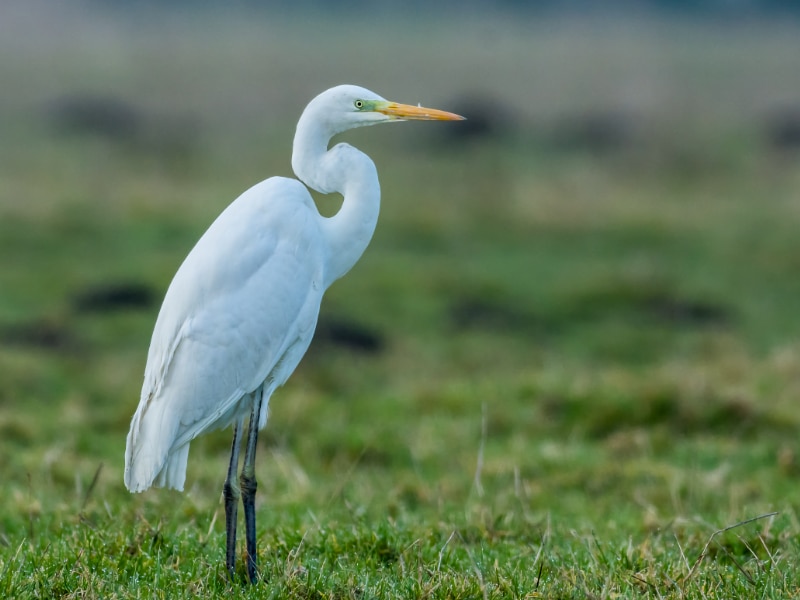
The great egret is a large white heron widely found across North America, measuring 80-104 centimeters (31.5-40.9 inches) in length and standing up to 140 centimeters (55.1 inches) tall. It has all-white plumage, a slender yellow bill, and long black legs and feet, with a graceful S-shaped neck that distinguishes it in flight.
During the breeding season, adults develop long, delicate scapular plumes called aigrettes, which extend beyond the tail and are displayed in elaborate courtship rituals. Soft part colors also change, with the bill turning more orange-yellow and the lores becoming bright lime-green.
Juveniles resemble nonbreeding adults but may show a dusky bill tip. In flight, the great egret moves with slow, measured wingbeats and a retracted neck, giving it a poised and buoyant appearance. It is generally silent, though low croaks and harsh calls are heard during breeding displays.
This species inhabits a wide range of freshwater and coastal wetlands, including marshes, lakes, ponds, estuaries, and flooded agricultural fields. In North America, it breeds in colonies often shared with other wading birds, nesting in trees, shrubs, or on islands over water. It forages in shallow wetlands, feeding primarily on fish but also taking amphibians, crustaceans, reptiles, insects, and small mammals. The great egret is a partial migrant: populations in the southern U.S. are mostly resident, while those breeding in northern states and southern Canada migrate south for the winter.
Once heavily hunted for its ornamental plumes, the species made a strong recovery after legal protection in the early 20th century. Today it remains widespread but is vulnerable to habitat degradation, pesticide exposure, and hydrological changes that reduce wetland quality.
Great white heron (Ardea herodias occidentalis)
- Identification: Largest heron in North America, with entirely white plumage, a yellow bill, and pale dusky legs.
- Where found: Mostly confined to coastal south Florida, the Florida Keys, and parts of the Caribbean.
- Region status: Native; very localized resident with occasional vagrants far inland and northward.
- Conservation status: Least Concern; locally vulnerable due to small population size and habitat disturbance.
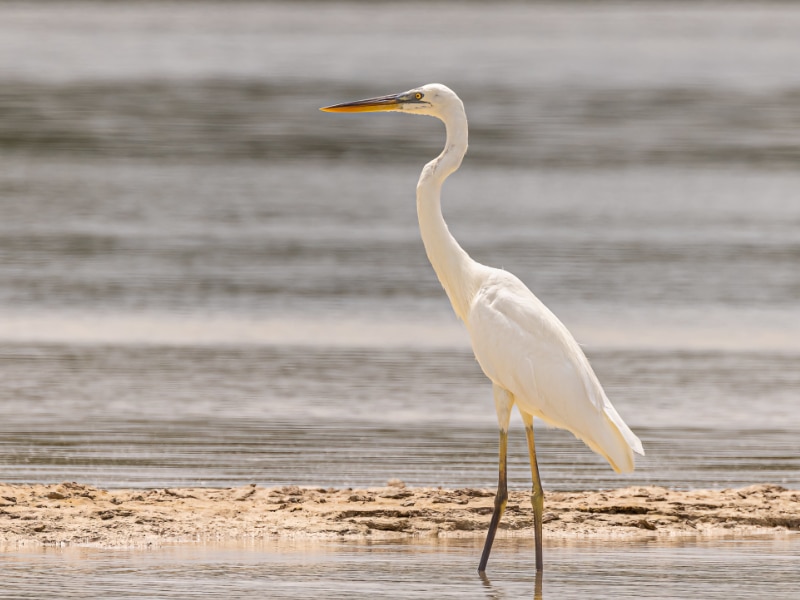
The great white heron is the all-white subspecies of the great blue heron and was once considered a separate species. It is the largest heron in North America, measuring 91-137 centimeters (35.8-53.9 inches) in length and standing around 160 centimeters (63 inches) tall, with a heavier build than a great egret. It is distinguished by pure white plumage, a thick, mostly yellow bill, and pale dusky-grey to yellowish legs, unlike the great egret’s darker black legs.
In flight, it retracts its long neck into an S-shape and extends its legs along the body, moving with deep, slow wingbeats. Adults have long body plumes, while juveniles lack these ornamental feathers but are otherwise similar in appearance. Compared to the superficially similar great egret, the great white heron is bulkier, less bright white, and often appears more deliberate in its movements. It is mostly solitary and quiet, usually stalking prey with slow, deliberate steps in shallow water.
This subspecies is largely restricted to coastal south Florida, especially the Florida Keys and Florida Bay, with small breeding populations in Cuba and a few other Caribbean islands. It favors saltwater habitats, including tidal flats, mangrove islands, and coastal ponds, and nests in mangrove vegetation or on isolated islets. Like other herons, it feeds mainly on fish but will also take crustaceans, amphibians, and small reptiles. Although primarily a resident bird, individuals sometimes wander widely, with rare vagrants recorded as far as Texas, the Great Lakes, and even maritime Canada.
Its very small core population makes it more vulnerable than other heron forms to habitat loss, coastal development, and disturbance at nesting sites, although it remains protected as part of the broader great blue heron population.
Wood stork (Mycteria americana)
- Identification: Large white wading bird with black flight feathers, bare dark grey scaly head and neck, and a long thick decurved bill.
- Where found: Breeds in wetlands of Florida, Georgia, and South Carolina; ranges through Mexico, Central America, and the Caribbean.
- Region status: Native; localized breeder in the southeastern U.S., disperses widely after nesting but not a true migrant.
- Conservation status: Least Concern globally; locally vulnerable to wetland loss, altered hydrology, and human disturbance at colonies.
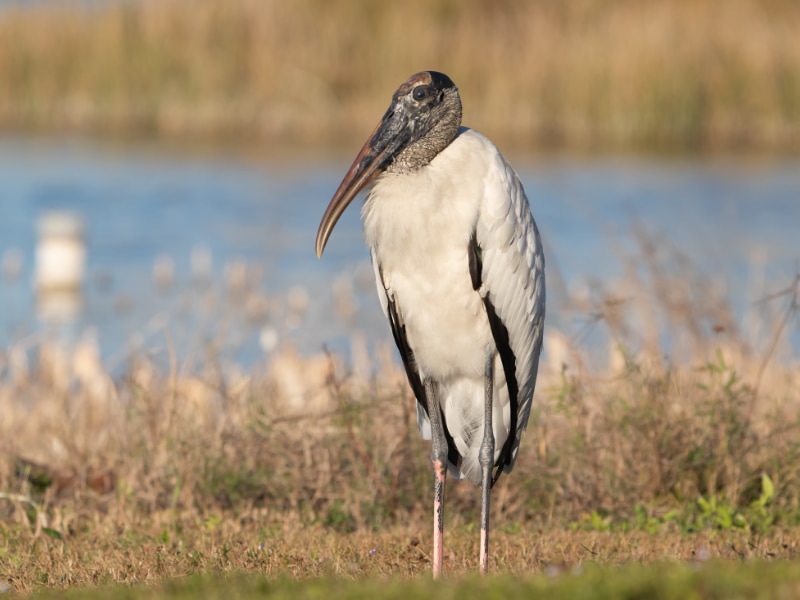
The wood stork is a large wading bird of the southeastern United States, measuring 83-115 centimeters (32.7-45.3 inches) in height. Adults are entirely white except for black primaries, secondaries, and tail feathers that show a greenish or purplish sheen in good light. The head and neck are unfeathered, dark grey, and scaly, giving the bird a prehistoric appearance. Its bill is long, thick at the base, and slightly decurved toward the tip.
In flight, wood storks are striking with their broad black-and-white wings, slow, steady wingbeats, and extended neck and legs. They are usually silent, though nestlings beg noisily and adults may clatter their bills during courtship.
In North America, wood storks breed mainly in Florida, Georgia, and South Carolina, nesting in flooded cypress swamps, mangroves, and coastal wetlands, often in colonies with other wading birds. They forage in shallow wetlands, tidal creeks, and flooded fields, where they sweep their open bills through the water, snapping shut when they sense prey. Their diet consists primarily of fish but also includes amphibians, crustaceans, and insects. After breeding, storks disperse widely, sometimes moving north before returning to Florida and nearby areas for winter, but they are not long-distance migrants.
While globally secure, southeastern U.S. populations were once federally listed as Endangered due to extensive wetland drainage and altered hydrology in Florida. Recovery efforts, wetland restoration, and the use of impounded or managed wetlands have allowed some population rebound, though loss of natural foraging habitat and disturbance at nesting colonies remain ongoing concerns.
White ibis (Eudocimus albus)
- Identification: Medium-sized white wader with black wingtips, pink face and legs, and a long decurved pink bill.
- Where found: Along the Gulf and Atlantic coasts of the southeastern U.S., especially Florida, and throughout the Caribbean and coastal Central America.
- Region status: Native and widespread, with shifting local populations and post-breeding dispersal northward.
- Conservation status: Least Concern; locally affected by wetland disturbance, mercury contamination, and colony site loss.

The white ibis is a medium-sized coastal wader of North America, measuring 53-70 centimeters (20.9-27.6 inches) in length. Adults are pure white with contrasting black wingtips visible in flight, a long slender pink bill that curves downward, and bare pink to reddish facial skin and legs.
In flight, the species shows rapid wingbeats with intermittent glides, often traveling in loose V-formations or long skeins. Foraging birds walk slowly through shallow water or soft mud, probing for prey with sensitive bill tips. Vocalizations include soft honking calls in flocks and a coarse “hunk-hunk-hunk” flight call.
In North America, the species breeds primarily in coastal wetlands from the Carolinas through Florida, Louisiana, and Texas, nesting in mangroves, marshes, or wooded wetlands. Colonies may also occur inland on islands in lakes and swamps. They forage in shallow freshwater marshes, salt marshes, and tidal flats, feeding mainly on crayfish, fiddler crabs, aquatic insects, and other invertebrates. White ibises are highly nomadic, shifting seasonally between inland and coastal wetlands depending on water levels and prey availability.
While the species is generally abundant, it faces localized threats from wetland drainage, human disturbance at nesting colonies, and contamination in polluted wetlands. Protecting both foraging areas and colony sites remains important for maintaining stable populations.
Snowy egret (Egretta thula)
- Identification: Medium-sized, slender white heron with a long black bill, black legs, and bright yellow feet.
- Where found: Coastal and inland wetlands across North America, especially estuaries, marshes, and shallow lakes.
- Region status: Native; widespread but partly migratory, more common in southern areas year-round.
- Conservation status: Least Concern; locally affected by wetland loss, competition at colonies, and contaminants.
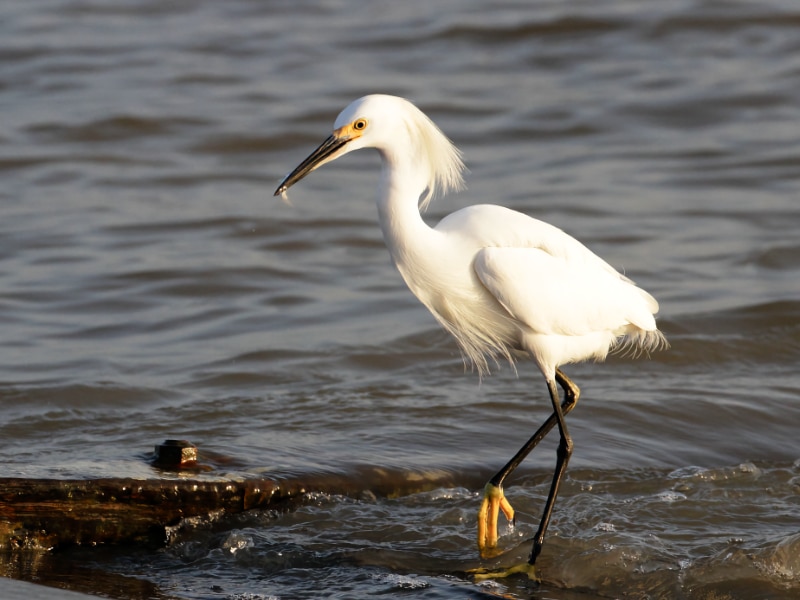
The snowy egret is a medium-sized white heron of North America, measuring 56-66 centimeters (22-26 inches) in length. It has entirely white plumage with a long, fine black bill and striking yellow lores in front of the eyes. Its slender black legs are tipped with vivid yellow feet that become more orange during breeding.
Breeding adults develop long, delicate plumes on the breast, back, and nape that form wispy sprays and a short crest. Nonbreeding adults and juveniles have duller, greenish-yellow feet and a paler base to the lower bill.
In flight, the bird shows a graceful, buoyant style with deep wingbeats and a slightly arched neck. When foraging, it often uses active methods such as foot-stirring and quick dashes to flush prey. It is mostly quiet but gives soft, rasping calls around nesting colonies, and males produce bubbling courtship calls.
This species is widely distributed, breeding in coastal wetlands, marshes, lakes, and estuaries across much of the United States, Mexico, the Caribbean, and Central America. In North America, it is a seasonal breeder in interior wetlands but remains resident year-round in warmer southern areas and along the Gulf and Atlantic coasts. It nests colonially, often in mangroves, dense shrubs, or small islands near stable feeding grounds. Snowy egrets feed mainly on small fish, crustaceans, amphibians, and insects, using shallow estuarine pools and tidal flats.
Once severely reduced by the plume trade, the species rebounded after protective legislation but faces ongoing threats from habitat loss, pesticide contamination, and nesting competition with other herons and egrets in some areas.
White-morph reddish egret (Egretta rufescens)
- Identification: Tall coastal heron with entirely white plumage, a distinctive two-toned pink-and-black bill, and blue-grey legs.
- Where found: Restricted to shallow tidal flats, lagoons, and coastal islands along the Gulf Coast, Florida Keys, Bahamas, Mexico, and the Caribbean.
- Region status: Native; patchy and uncommon, with white morphs forming a minority except in some areas like the Bahamas.
- Conservation status: Near Threatened; vulnerable to coastal habitat loss, disturbance at nesting sites, and historical plume hunting.

The white-morph reddish egret is a medium-sized coastal heron of North America, measuring 68-82 centimeters (26.8-32.3 inches) in length. Unlike the dark morph, it has entirely white plumage but retains the same characteristic features: a bicolored pink bill with a black tip and slate-blue legs. In breeding condition, adults develop slightly richer pink tones on the bill and pale lores, but the plumage remains white.
Compared to similar species like the snowy egret, the white-morph reddish egret is noticeably taller and bulkier and shows more vigorous, erratic foraging behavior – running, dashing, and spreading its wings to startle prey. In flight, it has a graceful but direct style with retracted neck and steady wingbeats. This heron is mostly silent, producing only soft raspy calls at close range around colonies or during courtship.
The species is confined to coastal areas, nesting mainly on isolated mangrove keys, barrier islands, and dredge-material islets in the Gulf of Mexico, Florida Keys, Texas coast, the Yucatan Peninsula, and parts of the Caribbean. It forages almost exclusively on tidal flats and hypersaline lagoons, feeding on small fish trapped in very shallow water.
Unlike many herons, it rarely occurs inland and is highly dependent on undisturbed coastal flats. Colonies are typically shared with other herons and seabirds, often over mangroves or low coastal vegetation.
Once severely depleted by plume hunting, the reddish egret has recolonized parts of its historic range but remains uncommon and highly localized. Coastal development, human disturbance, and habitat degradation continue to threaten breeding and feeding sites, making ongoing habitat protection and monitoring essential for its conservation.
Immature little blue heron (Egretta caerulea)
- Identification: White heron with a bicolored bill (dark tip, pale base), dull greenish legs, and blue-grey lores.
- Where found: Freshwater and coastal wetlands across the southeastern U.S., Gulf Coast, Mexico, the Caribbean, and parts of Central and South America.
- Region status: Native; widespread but partly migratory, dispersing after breeding and wintering farther south.
- Conservation status: Least Concern; local declines linked to wetland loss, human disturbance, and contaminants.

The immature little blue heron is a slender heron of North America, measuring 56-74 centimeters (22-29.1 inches) in length. Juveniles are entirely white during their first year, making them easily confused with snowy egrets, but they can be distinguished by their pale bluish-grey lores, dull greenish legs, and slower, more deliberate foraging style. Their bill is distinctly bicolored: dark toward the tip and pale bluish or greyish at the base.
During the first spring and summer, immatures develop blotchy blue-and-white “calico” plumage as they molt into the uniform slate-blue adult coloration. In flight, they appear graceful with steady wingbeats, typically flying low over wetlands. They are quiet outside colonies, producing only soft grunts or raspy alarm calls when disturbed.
This species breeds colonially in shrubs and low trees over swamps, mangroves, and dredged-material islands across the southeastern U.S., Gulf Coast, Caribbean, and parts of Mexico and Central America. Juveniles disperse widely after fledging, often appearing hundreds of miles north of breeding areas before migrating south to winter in coastal lagoons, mangroves, and tidal flats. They forage mostly alone or in small groups in shallow wetlands, feeding on small fish, amphibians, crustaceans, and aquatic insects.
While still relatively common, little blue herons are sensitive to wetland drainage, altered water regimes, pesticide contamination, and human disturbance near colonies. Protection of both nesting and foraging habitats is critical to maintaining stable populations in the region.
Western cattle egret (Ardea ibis)
- Identification: Stocky, short-necked white egret with a yellow bill, dark legs, and orange-buff plumes during breeding.
- Where found: Open fields, pastures, wetlands, and mixed-species heronries across much of the U.S., Mexico, and the Caribbean.
- Region status: Native; widespread and partly migratory, resident year-round in warmer southern areas.
- Conservation status: Least Concern; benefits from human-altered landscapes but can face pesticide exposure and disturbance at breeding sites.
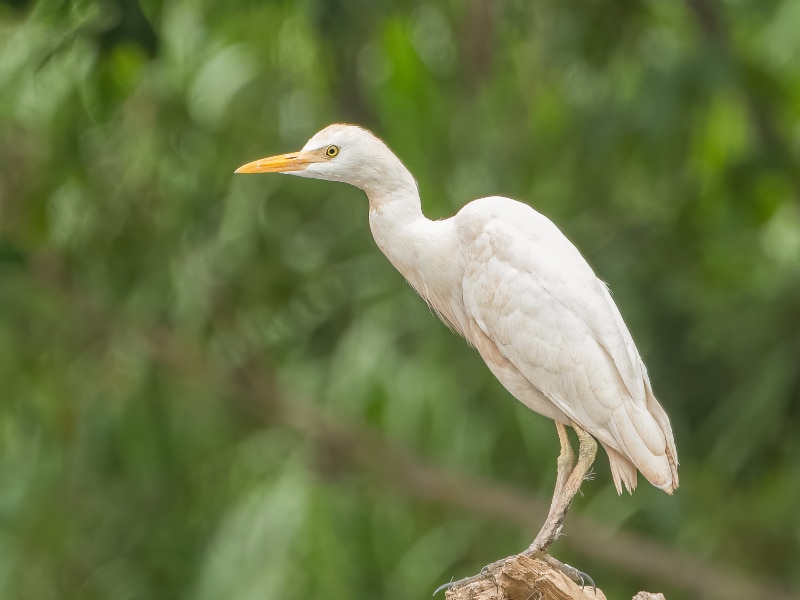
The western cattle egret is a compact white heron of North America, measuring 46-56 centimeters (18.1-22 inches) in length. Its short neck, thick body, and relatively small head give it a distinctive profile compared to other egrets.
Nonbreeding birds are entirely white with a yellow bill, yellow lores, and dark greenish legs that often appear black. In breeding plumage, adults develop soft orange-buff feathers on the head, breast, and back, while the bill and legs briefly turn reddish and the lores become pinkish-purple at peak courtship. Juveniles are all white but have dark bills and legs.
In the field, it is easily recognized by its habit of walking with a deliberate head-bobbing motion and its preference for foraging near large mammals or agricultural machinery. In flight, it appears more compact than other egrets, with a direct, low, and shallow-winged flight style. Vocalizations are simple and harsh, mostly limited to guttural calls at breeding colonies.
This species thrives in open habitats such as pastures, farmlands, wetlands, and grassy fields, often nesting in large mixed heronries near water but foraging primarily in upland areas. In North America, it breeds mainly across the southern and central U.S., with colonies along the Gulf Coast, southeastern coastal plain, and inland reservoirs, and migrates south in winter to Mexico, Central America, and the Caribbean. It feeds opportunistically on grasshoppers, crickets, spiders, frogs, and small vertebrates, often taking advantage of disturbed prey flushed by cattle, tractors, or fires.
Originally native to Africa, it rapidly expanded its range globally and adapted well to human-altered landscapes. While overall populations are stable or increasing, localized concerns include pesticide exposure in agricultural areas, habitat degradation near large colonies, and conflicts when nesting in urban or suburban areas.
Other large white birds you might see
The species covered above represent the most commonly observed large to mid-sized white birds with long or somewhat elongated beaks across North America. These are the birds you’re most likely to encounter in wetlands, coasts, and open fields when you find yourself wondering “what is this big white bird?.”
However, not all birds fall into the same category. Swans, while distinctive with their graceful S-shaped necks and overall silhouette, also fit the broader description of “large white birds,” though their bills are shorter and broader compared to herons, ibises, or pelicans.
Here’s a quick look at the three swan species you might see in North America:
Trumpeter swan (Cygnus buccinator)
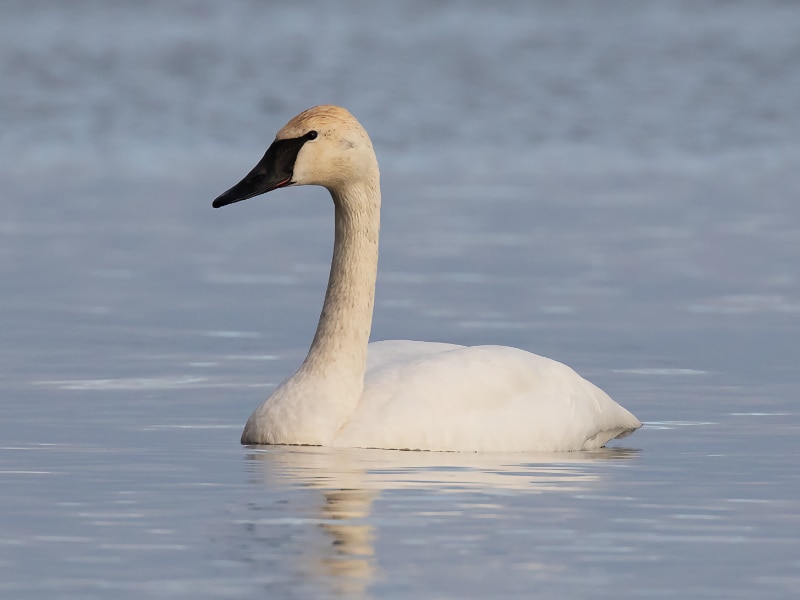
The trumpeter swan is North America’s largest native waterfowl, entirely white with a massive straight-edged black bill. Adults often show a rusty wash on the head and neck from iron-rich waters. It breeds across Alaska, western Canada, and parts of the northern U.S., favoring large shallow lakes, marshes, and ponds with abundant aquatic plants. In winter, it gathers on ice-free lakes, rivers, and estuaries, especially in the Pacific Northwest and the interior Midwest.
Tundra swan (Cygnus columbianus)

The tundra swan is slightly smaller, with an all-white body and a mostly black bill often showing a small yellow spot near the eye. It breeds in the Arctic tundra of Alaska and northern Canada, nesting near ponds and river deltas. In winter, two populations migrate separately: one to the Pacific Coast from British Columbia to California, and another to the Atlantic Coast from New Jersey to the Carolinas. They’re often seen in coastal wetlands, estuaries, and agricultural fields.
Mute swan (Cygnus olor)

An introduced Eurasian species, the mute swan is recognizable by its all-white plumage and an orange bill topped with a prominent black knob. It’s less migratory and prefers medium-sized lakes, lagoons, rivers, and ornamental ponds in parks or urban settings. Established feral populations now occur along the Atlantic Coast, around the Great Lakes, and in parts of the Pacific Northwest.
So, while swans are instantly recognizable by their long elegant necks and hefty bodies, they’re less often confused with herons, ibises, or egrets because of their shorter, broader bills and different feeding behavior. Still, knowing their key traits helps complete the picture of large white birds you may encounter across North America.
